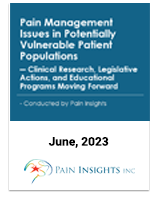Harmonizing Clinical Practice and Clinical Guidelines in the Management of Chronic Pain — From the Patient Perspective
A market research study assessing pain management trends in the United States among 1,000 patients suffering from moderate-to-severe chronic pain
Pain Insights, Inc. announces a comprehensive market research study conducted among 1,000 patients with moderate-to-severe chronic pain. In this baseline report, Pain Insights reviewed therapy from a patient-centered viewpoint, looking at metrics measuring patient satisfaction/outcomes, their involvement in the decision making process, the changing patient-practitioner relationship, the impact of recent guideline recommendations, as well as patient views on the use of opioids, non-opioids, and non-pharmacologic therapies for chronic pain.
The findings will lend insights into: patient engagement activities, patient-reported outcomes (PROs), educational initiatives, new product development and strategic planning strategies, target product profiles (TPPs), REMS-related initiatives, and market segmentation.
To provide context, the report includes numerous representative patient verbatims on the current state of pain management and their suggestions for improvement.
Study goals & content:
- Establish metrics to gauge awareness and impact of recent guidelines (e.g. CDC)
- Ascertain the most desired patient-reported outcomes (PROs) relating to functional performance
- Uncover the most significant impacts of pain on functioning (pain interference)
- Analyze the patient journey, retrospectively and prospectively, for patients currently taking opioids, patients with past opioid exposure, and opioid naïve patients
- Market segmentation identified four patient groups based on acceptance of pain control therapies, receptivity to enhanced patient-provider communication and new policies relating to the usage of opioids for chronic pain
- Assess the perceived need for and willingness to pay for abuse-deterrent opioid formulations
- Establish baseline metrics regarding patient attitudes, experiences, and satisfaction with outcomes involving opioid therapy and monitoring
- Patient acceptance of risk management protocols to inform REMS-related initiatives
- Investigate key issues, such as benzodiazepine use, in-home naloxone, Emergency Department visits, appropriate storage/disposal, post-surgical chronic pain, the use of OTC analgesics, etc.
- And most importantly, determine steps that can be taken to improve chronic pain therapy from the patient perspective - patients recommend an “all of the above approach”
Drugs/drug categories included in this report:
- Over-the-Counter analgesics
- Nonsteroidal anti-inflammatory drugs
- Celebrex
- Prescription Topical NSAIDs
- Prescription Topical Lidocaine
- Antidepressants
- Neuromodulators
- Benzodiazepines
- Muscle Relaxants
- Corticosteroid injections
- Hyaluronic acid injections
- Medicinal marijuana
- Immediate-release Opioids
- Extended-release Opioids
Non-drug therapies included in this report:
- Chiropractic manipulation
- Acupuncture
- Transcutaneous electrical nerve stimulation (TENS)
- Physical therapy
- Exercise
- Rest or sleep
- Biofeedback
- Cognitive behavioral therapy (CBT)
- Nutritional/Herbal supplements
- Ultrasound
- Spinal-cord stimulation (SCS)
- Radio-frequency ablation (RFA)
The principals at Pain Insights, Inc. have researched issues pertinent to hydrocodone and the management of pain for more than 25 years. We are pleased to make this timely report available to provide you with insights into the current hydrocodone marketplace.
or order complete report
To order your report or for additional details please contact:
William Kolek, President, Pain Insights, Inc. (Email)
or
Bob Catuosco, Vice President, Pain Insights, Inc. (Email)
Report format: PowerPoint - Executive Summary/Detailed Findings (261 pgs.)
The Powerpoint-style report will be emailed as a PDF.
Presentations available upon request.

